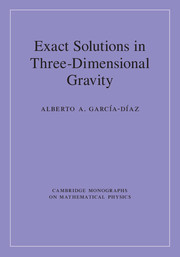Book contents
- Frontmatter
- Contents
- Preface
- 1 Introduction
- 2 Point Particle Solutions
- 3 Dust Solutions
- 4 A Shortcut to (2+1) Cyclic Symmetric Stationary Solutions
- 5 Perfect Fluid Static Stars; Cosmological Solutions
- 6 Static Perfect Fluid Stars with Λ
- 7 Hydrodynamic Equilibrium
- 8 Stationary Circularly Symmetric Perfect Fluids with Λ
- 9 Friedmann–Robertson–Walker Cosmologies
- 10 Dilaton–Inflaton Friedmann–Robertson–Walker Cosmologies
- 11 Einstein–Maxwell Solutions
- 12 Black Holes Coupled To Nonlinear Electrodynamics
- 13 Dilaton Field Minimally Coupled to (2 + 1) Gravity
- 14 Scalar Field Non-Minimally Coupled to (2+1) Gravity
- 15 Low-Energy (2+1) String Gravity
- 16 Topologically Massive Gravity
- 17 Bianchi-Type (BT) Spacetimes in TMG; Petrov Type D
- 18 Petrov Type N Wave Metrics
- 19 Kundt Spacetimes in TMG
- 20 Cotton Tensor in Riemannian Spacetimes
- References
- Index
12 - Black Holes Coupled To Nonlinear Electrodynamics
Published online by Cambridge University Press: 30 August 2017
- Frontmatter
- Contents
- Preface
- 1 Introduction
- 2 Point Particle Solutions
- 3 Dust Solutions
- 4 A Shortcut to (2+1) Cyclic Symmetric Stationary Solutions
- 5 Perfect Fluid Static Stars; Cosmological Solutions
- 6 Static Perfect Fluid Stars with Λ
- 7 Hydrodynamic Equilibrium
- 8 Stationary Circularly Symmetric Perfect Fluids with Λ
- 9 Friedmann–Robertson–Walker Cosmologies
- 10 Dilaton–Inflaton Friedmann–Robertson–Walker Cosmologies
- 11 Einstein–Maxwell Solutions
- 12 Black Holes Coupled To Nonlinear Electrodynamics
- 13 Dilaton Field Minimally Coupled to (2 + 1) Gravity
- 14 Scalar Field Non-Minimally Coupled to (2+1) Gravity
- 15 Low-Energy (2+1) String Gravity
- 16 Topologically Massive Gravity
- 17 Bianchi-Type (BT) Spacetimes in TMG; Petrov Type D
- 18 Petrov Type N Wave Metrics
- 19 Kundt Spacetimes in TMG
- 20 Cotton Tensor in Riemannian Spacetimes
- References
- Index
Summary
In (3+1) gravity it is well known that the vacuum plus a cosmological constant Λ, i.e., the (anti) de Sitter–Kottler (1918) solution, is a regular non-asymptotically flat solution (the scalar curvature is equal to 4Λ and all the invariants of the conformal Weyl tensor are zero.) On the other hand, Einstein–Maxwell electrovacuum asymptotically flat metrics endowed with timelike and spacelike symmetries do not allow for the existence of regular black hole solutions. In order to be able to derive regular (black hole) solutions one has to enlarge the class of electrodynamics to nonlinear ones; as an example, the regular solution by Ayón–Beato and García (1998), which is a solution to gravitational–nonlinear electromagnetic fields; the first examples belonging to this class are the Borde (1997) model and the Ayón–García regular charged static black hole.
In (2+1) gravity, in the vacuum case, all solutions are locally Minkowski (the Riemann tensor is zero); the extension to the vacuum plus cosmological constant allows for the existence of the static and the rotating anti-de Sitter regular black holes; see Bañados et al. (1992). The static (2+1)-charged black hole with cosmological constant is singular (when radial coordinate goes to zero the curvature and the Ricci square invariants blow up). Similarly, as in (3+1) gravity, one may search for regular solutions in (2+1) gravity incorporating nonlinear electromagnetic fields to which one imposes the weak energy conditions in order to have physically plausible matter-field distributions. One may look for regular solutions with nonlinear electromagnetic fields of the Born–Infeld type (Born and Infeld, 1934); Salazar et al. (1987); Salazar et. al (1984); Gibbons and Rasheed (1995); Fradkin and Tseytlin (1985); Deser and Gibbons (1998), and/or electrodynamics of wider spectra (Cataldo and García, 1999, 2000; Cataldo et al., 2000).
The Born–Infeld electrodynamics (Born and Infeld, 1934) is free from certain singularities appearing in the classical Maxwell electromagnetic field theory. Nonlinear electromagnetic Lagrangians, in particular the Born–Infeld Lagrangian, arise in open string theory (the low-energy effective action for an electromagnetic field is precisely the Born–Infeld action; see Fradkin and Tseytlin, 1985); string theory has emerged as the most promising candidate for the consistent quantization of gravity. In particular, the open string theory has Born–Infeld coupled vector fields, but it is not clear that this remains the case after compactification to a 3D space with negative cosmological constant Λ.
- Type
- Chapter
- Information
- Exact Solutions in Three-Dimensional Gravity , pp. 240 - 256Publisher: Cambridge University PressPrint publication year: 2017

